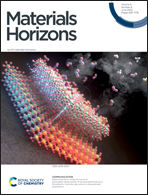Multistep nucleation visualized during solid-state crystallization†
Abstract
Mechanisms of nucleation have been debated for more than a century, despite successes of classical nucleation theory. The nucleation process has been recently argued as involving a nonclassical mechanism (the “two-step” mechanism) in which an intermediate step occurs before the formation of a nascent ordered phase. However, a thorough understanding of this mechanism, in terms of both microscopic kinetics and thermodynamics, remains experimentally challenging. Here, in situ observations using transmission electron microscopy on a solid-state nucleation case indicate that early-stage crystallization can follow the non-classical pathway, yet proceed via a more complex manner in which multiple metastable states precede the emergence of a stable nucleus. The intermediate steps were sequentially isolated as spinodal decomposition of amorphous precursor, mass transport and structural oscillations between crystalline and amorphous states. Our experimental and theoretical analyses support the idea that the energetic favorability is the driving force for the observed sequence of events. Due to the broad applicability of solid-state crystallization, the findings of this study offer new insights into modern nucleation theory and a potential avenue for materials design.



 Please wait while we load your content...
Please wait while we load your content...